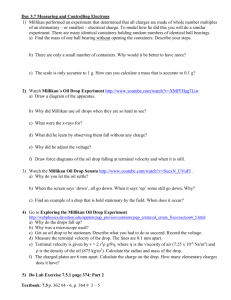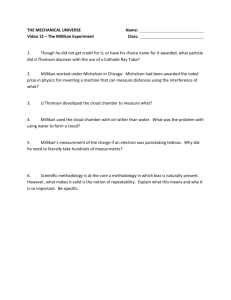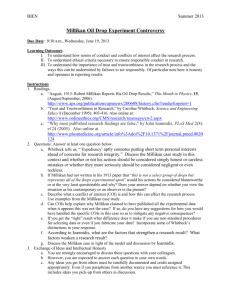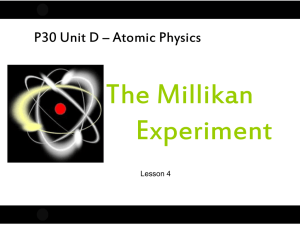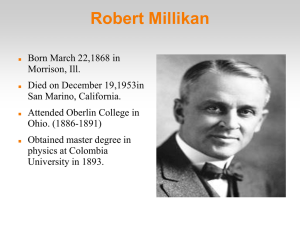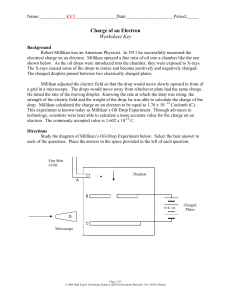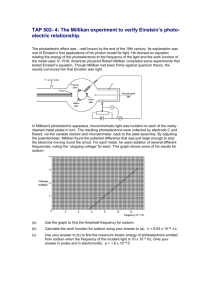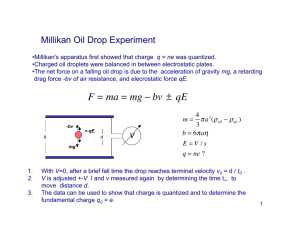Note-A-Rific: Millikan - Physics
advertisement
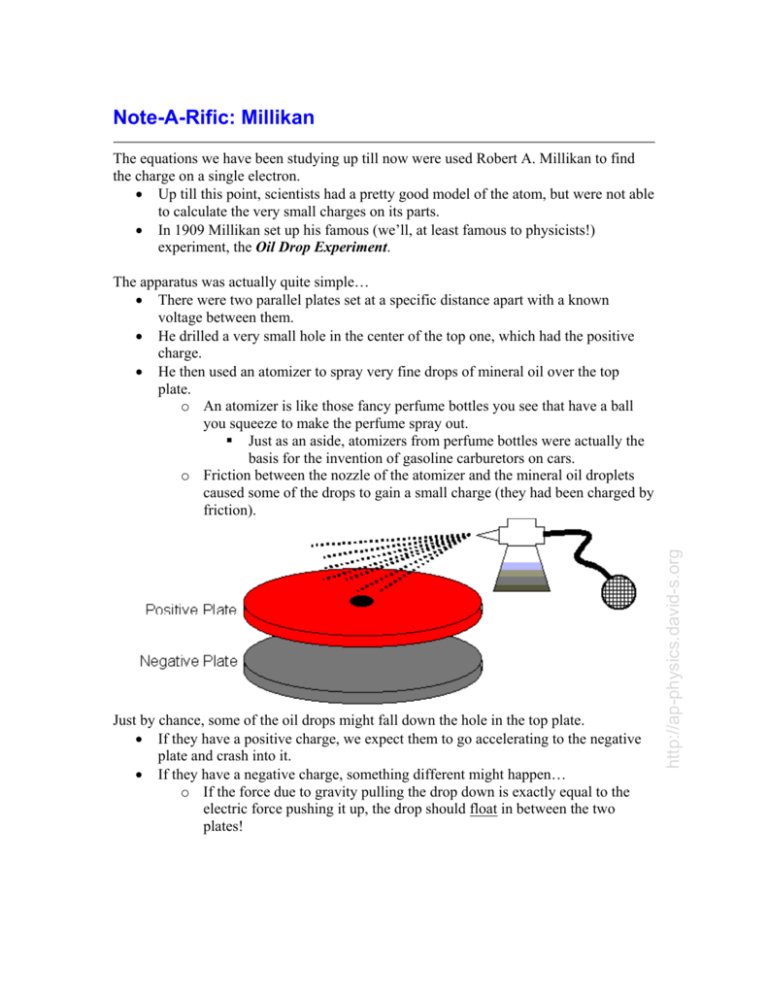
Note-A-Rific: Millikan The equations we have been studying up till now were used Robert A. Millikan to find the charge on a single electron. • Up till this point, scientists had a pretty good model of the atom, but were not able to calculate the very small charges on its parts. • In 1909 Millikan set up his famous (we’ll, at least famous to physicists!) experiment, the Oil Drop Experiment. Just by chance, some of the oil drops might fall down the hole in the top plate. • If they have a positive charge, we expect them to go accelerating to the negative plate and crash into it. • If they have a negative charge, something different might happen… o If the force due to gravity pulling the drop down is exactly equal to the electric force pushing it up, the drop should float in between the two plates! http://ap-physics.david-s.org The apparatus was actually quite simple… • There were two parallel plates set at a specific distance apart with a known voltage between them. • He drilled a very small hole in the center of the top one, which had the positive charge. • He then used an atomizer to spray very fine drops of mineral oil over the top plate. o An atomizer is like those fancy perfume bottles you see that have a ball you squeeze to make the perfume spray out. ! Just as an aside, atomizers from perfume bottles were actually the basis for the invention of gasoline carburetors on cars. o Friction between the nozzle of the atomizer and the mineral oil droplets caused some of the drops to gain a small charge (they had been charged by friction). • Since the force due to the electric field and the force due to gravity are equal, it is possible to derive an equation to calculate the charge on the droplet. • To find the charge on the droplet, Millikan needed to know three things: 1. g # the acceleration due to gravity was easily measured by Millikan. For our calculations, we will continue to assume 9.81m/s2. 2. E # the electric field in the plates could be calculated by measuring the distance between the plates and the voltage. You then use E = V/d to calculate the electric field. 3. m # the mass of the droplet proved the most difficult to measure. How do you measure the mass of an oil droplet? Especially since it usually only floated for a couple of seconds and then splattered on the bottom or top plate. Millikan had two solutions to this problem… • First, he used a miniature telescope with hash lines etched onto the glass. • If you looked into the scope you’d see something like this: • • • By knowing the distance between the hash marks, Millikan could measure the diameter of the oil drops. There was still one problem… as the oil drops fell, they had a raindrop shape. o This meant that Millikan couldn’t just calculate the volume of a perfect sphere for his calculations. This led to his second solution. http://ap-physics.david-s.org FE = Fg qE = mg mg q= E • Based on a series of complex calculations using the viscosity (thickness), air resistance, and other properties of mineral oil, Millikan was able to relate the diameter of the oil drop to its mass. Now all he had to do was see one of these oil drops float in front of the scope. • Oh, is that all! • Millikan spent thousands of hours squinting through that scope, desperately trying to see drops float and quickly measure their diameter. • After thousands of trials, Millikan was able to show that all of the charges he calculated were multiples of one number… 1.60 x 10-19 C • Since he never spotted a smaller charge, he concluded this must be the charge on a single electron (and proton). • Because it is the most basic charge possible he called it an elementary charge. Example: An oil drop in a Millikan apparatus is determined to have a mass of 3.3 x 10-15 kg. It is observed to float between two parallel plates separated by a distance of 1.0cm and with a 340V potential difference between them. How many excess (extra) electrons are on the drop? • We first need to calculate the strength of the electric field between the two plates. E = V / d = (340V) / 0.010m) = 3.4 x 104 N/C Now we can calculate the charge on the drop. FE = Fg qE = mg mg (3.3x10 −15 kg)(9.81m / s 2 ) q= = = 9.5x10 −19 C 4 E 3.4x10 N / C But the question asked how many excess electrons are on the drop, not for the charge. Since we know one electron has a charge of 1.60 x 10-19 C… (9.5 x 10-19C) / (1.60 x 10-19 C) = 5.9 We round this off to get the final answer, six excess electrons. http://ap-physics.david-s.org Note: as of 1986 the most precise and accurate measurement of e, the elementary charge, is 1.6021773349 x 10-19 C

